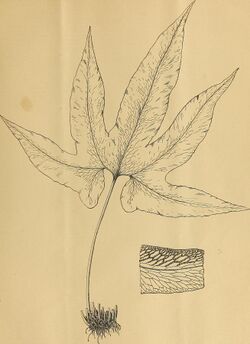Biology:Bommeria
| Bommeria | |
|---|---|

| |
| Bommeria elegans | |
| Scientific classification | |
| Kingdom: | Plantae |
| Clade: | Tracheophytes |
| Division: | Polypodiophyta |
| Class: | Polypodiopsida |
| Order: | Polypodiales |
| Family: | Pteridaceae |
| Subfamily: | Cheilanthoideae |
| Genus: | Bommeria Fourn. |
| Type species | |
| Bommeria ehrenbergiana (Klotzsch) Underwood
| |
| Species | |
|
See text. | |
| Synonyms | |
| |
Bommeria is a genus of small pteridaceous rock ferns, native to the New World. Genetic analysis has shown it to be a stem offshoot clade of all the cheilanthoid ferns (in family Pteridaceae),[1] except for Doryopteris, which is an even more basal ("primitive") stem offshoot. for years, it was assumed that this genus was closely allied with Hemionitis, but genetic analysis has shown that genus to be a more advanced genus evolutionarily. The same set of analysis has shown many presumed genera within this family to be paraphyletic, but the small genus Bommeria appears to be monophyletic, or a natural genus.
Bommeria is a "gymnogrammoid" fern, exhibiting unprotected sori aligned along veins on the undersides of the fronds. This is why it was assumed to be closely allied to Hemionitis. Such a feature is strongly at odds with most pteridoid ferns (Pteridaceae), which typically have linear marginal sori with an indusium, and sometimes protected with a reflexed leaf tissue margin. Apparently, this is a trait that can arise independently, and may be an atavistic trait.
The stipes (leaf stems) of Bommeria are hairy, with some scales, and the fronds are hairy, both above and below. The hairs above and short and sharp, while the hairs below may be straight or curled. Scales are also present on the bottoms of the fronds.
The genus name honors Belgian botanist Jean-Édouard Bommer.[2] The basal chromosome number for this genus is 2n=60 (n=30).
Phylogeny
(As of January 2020), the Checklist of Ferns and Lycophytes of the World recognized the following species:[3]
| Phylogeny of Bommeria[4][5] | |||||||||||||||||||||||||||
|---|---|---|---|---|---|---|---|---|---|---|---|---|---|---|---|---|---|---|---|---|---|---|---|---|---|---|---|
|
References
- ↑ Christenhusz, Maarten J. M.; Zhang, Xian-Chun; Schneider, Harald (18 February 2011). "A linear sequence of extant families and genera of lycophytes and ferns". Phytotaxa 19: 7–54. doi:10.11646/phytotaxa.19.1.2. ISSN 1179-3163. http://www.mapress.com/phytotaxa/content/2011/f/pt00019p054.pdf.
- ↑ Burkhardt, Lotte (2022) (in German) (pdf). Eine Enzyklopädie zu eponymischen Pflanzennamen. Berlin: Botanic Garden and Botanical Museum, Freie Universität Berlin. doi:10.3372/epolist2022. ISBN 978-3-946292-41-8. https://doi.org/10.3372/epolist2022. Retrieved January 27, 2022.
- ↑ Hassler, Michael; Schmitt, Bernd (November 2019), "Oeosporangium", Checklist of Ferns and Lycophytes of the World, 8.11, https://worldplants.webarchiv.kit.edu/ferns/, retrieved 2020-01-01
- ↑ Nitta, Joel H.Expression error: Unrecognized word "et". (2022). "An Open and Continuously Updated Fern Tree of Life". Frontiers in Plant Science 13: 909768. doi:10.3389/fpls.2022.909768. PMID 36092417.
- ↑ "Tree viewer: interactive visualization of FTOL". 2023. https://fernphy.github.io/viewer.html.
Further reading
- Haufler, Christopher H. "A biosystematic revision of Bommeria." Journal of the Arnold Arboretum 60:445-476. 1979.
- Maxon, William. "Studies of Tropical American Ferns." Contributions from the United States National Herbarium, Volume 17, United States National Herbarium, United States. Division of Botany, United States National Museum. 1916.
- Windham, M.D., L. Huiet, E. Schuettpelz, A.L. Grusz, C. Rothfels, J. Beck, G. Yatskievych, and K.M. Pryer. "Using plastid and nuclear DNA sequences to redraw generic boundaries and demystify species complexes in cheilanthoid ferns." American Fern Journal 99: 128–132. 2009.
- Yarborough, Sharon C. and A. Michael Powell. Ferns and Fern Allies of the Trans-Pecos and Adjacent Areas. Texas Tech University Press, Texas. 2002. 116pp, b/w ill, maps, PB. ISBN:0-89672-476-X. (for Bommeria hispida and genus description)
Wikidata ☰ Q4940889 entry
 |

